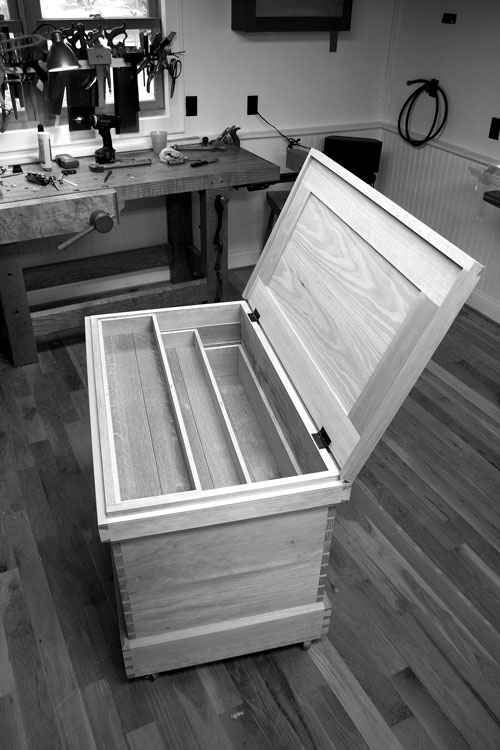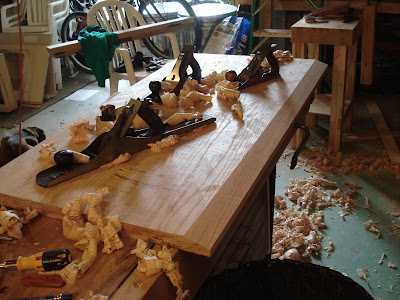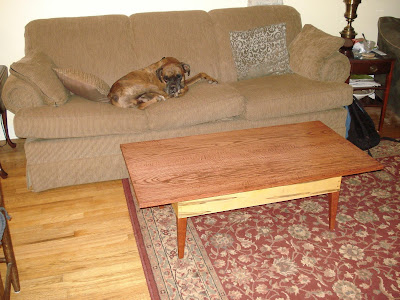Virginia is over 2 months old now and the new "normal" is starting to settle in. All is well in our household.
I've been out in the garage some too, thanks to the generosity of my wife. I finished a little companion side table in the same style as the coffee table:
If you're interested in the construction techniques, just read the last few posts and add a mortised shelf into the legs...it was basically the same thing with different dimensions. I did have a little help tapering the legs though:
I've been acquiring a few additional tools recently and I'm starting to run out of storage space for them. Various current storage solution integrated into my bench have served me well for the past year, but now I have more saws than can fit on the end, more hand planes than I have hangers for, and more chisels than can fit in the little area on the bench corner...truly, woe is me. I also got a sweet Lie-Nielsen router for my birthday and it's just been floating around the garage, pitifully homeless. This is no way to live.
Serendipitously enough, The Anarchist's Tool Chest, by Chris Schwarz is sweeping the nation, offering relief for those with just this problem. ATC offers sage advice for assembling a functional set of hand tools and ends with a design for a chest in which to hold them. My wife (did I mention she is generous) got me a copy for my birthday...
..and so it begins.
Here's Chris's (unpainted):
 |
| http://lostartpress.wordpress.com/2010/12/12/men-of-the-earth/ |
I'm making mine primarily out of cypress, it's local, light, water-/rot-resistant, relatively inexpensive, and just about the easiest wood in the world to work. Tonight I finally finished dovetailing the body. The two long faces are the tail boards and I cut them together:
I've been wanting a beefier rip backsaw than my little Gramercy dovetail saw for some time now. If money wasn't an issue I'd be on the waiting list for this guy, brass-backed, open mesquite handle, please. But money is a factor, so I pulled the trigger on one of the undisputed best values in woodworking, a Veritas backsaw. I was torn between the standard dovetail and the carcass and went with the carcass (band name, anyone?) saw in the end (bought in the presence of Frank Klausz at Highland's Fall shindig).
I like it. It cuts fast and straight; what else could you ask for in a saw? Good looks? Well yeah, there's that issue...oh well.
Lots of sawing and chopping later:
It never gets old. There are some subtleties here that aren't immediately obvious. The tail board (top) is two boards glued together while the pin board is three. Their seams don't line up: this ensures that even if the glue were to fail, the frame would still be held together by the dovetail joint. If their seams lined up there would be a chance that the whole chest could separate in two (a top and a bottom) if it were lifted by its top. Also, on the tail board, the seams terminate in the tails, not the tail sockets; on the pin board, the seams terminate in the pins, not the pin sockets. This is so that the joint is actually clamping those seams tighter, not trying to open them up.
Bottom line: it'll hold.
I made a simple caul for the glue-up to ensure that the tails seat fully into their sockets.
I've marked the material that I want to leave with a Sharpie. Then I cut a little saw kerf and chiseled away the waste in between the marked areas.
Now I can exert all the clamping force where it needs to be: on the tails.
So that's where I am now, my first corner is drying right now. I'm using Titebond Liquid Hide Glue on this project which is great for these massive joints because of its long working time; however its long set time will slow a project down a little bit. For those of you who were wondering, they don't call it "hide" glue because it's hard to see. Look it up.
That's all for now, I'll write again when I reach another good stopping point and time permits.






















































